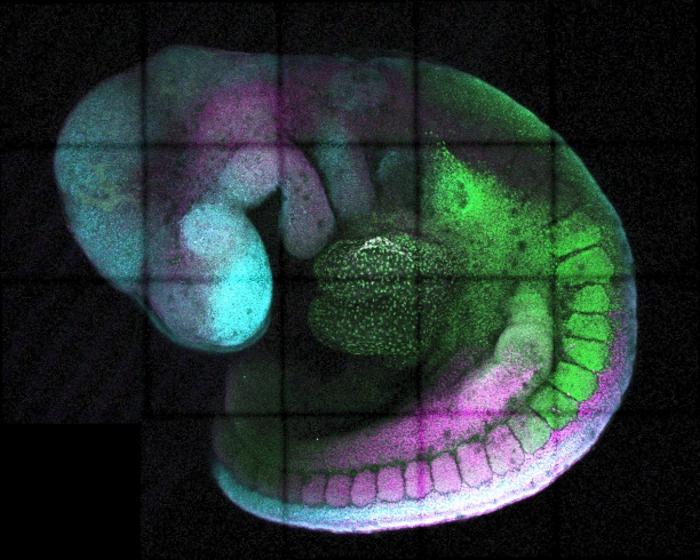In a groundbreaking study published in Developmental Cell, researchers have unveiled an intricate genetic mechanism that finely tunes the temporal expression of the critical developmental gene Cdx2 during early mammalian embryogenesis. This discovery promises to redefine our understanding of gene regulation during body plan formation and opens new avenues for precision gene modulation in therapeutic contexts.
The research team, led by Dr. Irène Amblard and Dr. Vicki Metzis of the Development and Transcriptional Control group at the MRC Laboratory of Medical Sciences, embarked on an ambitious project to dissect how gene expression is precisely controlled in developing embryos. Although all cells in an organism house the same genomic blueprint, they differentiate into diverse tissues and organs by selectively activating and repressing specific genes—a process known as gene expression. The temporal dynamics of this activation are critical, yet how the duration of gene expression is achieved at a molecular level has remained an elusive question until now.
Focusing specifically on the gene Cdx2, which plays a pivotal role in patterning the posterior part of the developing embryo, the team discovered that the timing of Cdx2 expression is governed by a previously uncharacterized DNA element. Unlike classical enhancers or silencers that broadly switch genes on or off, this novel regulatory element functions to attenuate gene transcription in a highly cell type- and time-specific manner. This “attenuator” behaves like a genetic dimmer switch, subtly adjusting the strength and duration of Cdx2 expression rather than merely toggling its presence.
.adsslot_jXL6xwVheJ{ width:728px !important; height:90px !important; }
@media (max-width:1199px) { .adsslot_jXL6xwVheJ{ width:468px !important; height:60px !important; } }
@media (max-width:767px) { .adsslot_jXL6xwVheJ{ width:320px !important; height:50px !important; } }
ADVERTISEMENT
Using sophisticated genetic engineering techniques, the researchers manipulated this attenuator element in mouse embryos. They demonstrated that modifications to the attenuator substantially altered the expression kinetics of Cdx2, thereby influencing the formation of spinal cord progenitors along the anterior-posterior axis. The results indicate that without the precise tuning from the attenuator, the spatial organization and subsequent development of posterior body structures are disrupted, underscoring the element’s critical biological function.
Mechanistically, this attenuator appears to act through interactions with specific transcription factors and chromatin remodeling complexes, orchestrating a dynamic regulatory landscape that permits fine-tuned control over gene expression windows. This precision control may serve as a general principle beyond Cdx2, potentially applying to numerous developmentally important genes whose expression must be tightly regulated both spatially and temporally.
The implications of this discovery are profound. By revealing a molecular “dimmer switch” for gene expression, the study provides a conceptual framework upon which programmable gene regulation tools can be developed. Such tools could enable scientists and clinicians to customize gene activity with unprecedented temporal and spatial resolution, facilitating innovative strategies to rectify developmental disorders and diseases rooted in misregulated gene expression.
Clinically, the ability to modulate gene expression precisely holds transformative potential. Current gene therapies largely rely on on/off gene activation systems, which lack the nuance required for many complex diseases. This new insight into attenuator elements might form the basis for gene therapies that can dial expression levels up or down as needed, minimizing side effects and maximizing therapeutic efficacy.
Moreover, this work adds to a growing body of research highlighting the importance of non-coding regions of the genome. These regions, once dismissed as “junk DNA,” are now recognized as key modulators of gene expression, acting through sophisticated regulatory elements like enhancers, silencers, and now attenuators. The ongoing exploration of these non-coding sequences will likely continue to reshape our understanding of genetic regulation in health and disease.
Dr. Metzis emphasized the broader significance: “Our genome likely harbors many such finely-tuned regulatory elements waiting to be discovered. Unlocking their mechanisms will revolutionize how we approach gene regulation and disease treatment. We view this as an exciting step toward harnessing the full regulatory potential of the genome.”
The study also underscores the power of collaborative, interdisciplinary research. Integration of developmental biology with computational genomics and chromatin biology was pivotal in identifying and characterizing this attenuator element. The team combined high-resolution imaging, gene editing, and transcriptomic analyses to produce a comprehensive picture of gene regulatory dynamics.
Funded by the Wellcome Trust and supported by the Medical Research Council, this research not only enhances fundamental scientific knowledge but also bridges the gap toward actionable therapeutic innovations. As the field progresses, the manipulation of attenuator and other emerging regulatory elements could become standard practice in regenerative medicine and personalized treatments.
In essence, this discovery represents a paradigm shift in our conception of gene regulation during development. It emphasizes that gene expression is not simply a matter of on or off, but involves finely honed modulation, akin to controlling the intensity of light with a dimmer switch. This nuanced control is vital for the correct emergence of complex body structures and offers a blueprint for future medical applications where precision is paramount.
Subject of Research: Animals
Article Title: A dual enhancer-attenuator element ensures transient Cdx2 expression during posterior body formation
News Publication Date: 27-Jun-2025
Web References:
DOI: 10.1016/j.devcel.2025.06.006
Therapeutic strategies targeting the non-coding genome
Image Credits: Irene Amblard, Development & Transcriptional Control Group, MRC Laboratory of Medical Sciences
Keywords: Developmental biology
Tags: Cdx2 gene expression dynamicsdevelopmental biology breakthroughsDr. Irène Amblard researchembryo development regulationgene expression differentiation in tissuesgene regulation in embryonic developmentgenetic tuning mechanismsmammalian embryogenesis researchMRC Laboratory of Medical Sciencesprecision gene modulation therapiestemporal gene expression controltranscriptional control in embryos





